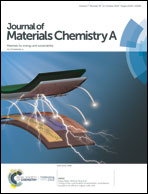Enhanced catalytic activity of SOx-incorporated graphene for the hydrogen evolution reaction†
Abstract
Sulfur defects have been used to enhance the catalytic activity of carbon-based nanostructures in the hydrogen evolution reaction (HER). This is accomplished by increase in the hydrogen adsorption ability due to the large size of sulfur atoms, which increases the sp3 character of graphene carbons. However, the effect of sulfur oxidation on the HER activity has not yet been discussed, even though sulfur can easily be oxidized to sulfur oxide (SOx) in acidic environments, which may decrease the metallicity of graphene by opening the bandgap. Herein, we systematically investigate the HER activity of SOx-incorporated graphene, SOx@G (x = 2, 3 or 4), based on electronic, thermodynamic and kinetic viewpoints. Our results reveal that SO3@G on the basal plane has superior HER catalytic activity due to its metallic nature and ability to stabilize adsorbed hydrogen (H*) which results from electrostatic interactions between SO3 and H* in an intermediate state. As a thermodynamic descriptor of the HER activity, the hydrogen binding Gibbs free energy (ΔGVolmerH*) is calculated to be −0.04 eV for SO3@G in the Volmer step. In addition, the activation energies in both the Volmer and Tafel steps (ΔEVolmera and ΔETafela, respectively) of SO3@G show the lowest energy barriers among SOx@G, taking values of 0.005 eV and 0.14 eV, respectively. Thus, these values can be used as kinetic descriptors and are close to those of conventional Pt catalysts.



 Please wait while we load your content...
Please wait while we load your content...